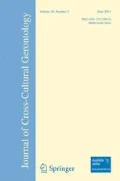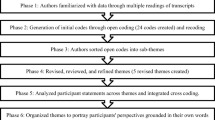Abstract
This study examined the concept of successful aging using an ethnographic grounded-theory approach. Seventy-seven Japanese American older adults participated in focus groups. Participants perceived successful aging as optimal functioning in the following areas: Physical health, psychological health, cognitive functioning, socialization, spirituality, and financial security. The content of each dimension represents both culture-specific and culturally-universal elements. This new multidimensional model of successful aging was compared to Rowe and Kahn’s (The Gerontologist 37:433–440, 1997) and Phelan et al.’s frameworks (Journal of the American Geriatric Society 52:211–216, 2004) of successful aging. The model of successful aging generated from this study appears to be more comprehensive than existing models and incorporates sociocultural experiences.

Similar content being viewed by others
References
Administration on Aging (2004). A Profile of Older Americans: 2003. Retrieved October 15, 2005 from http://www.aoa.gov/prof/Statistics/profile/2003/4.asp
Albert, M. S., Jones, K., Savage, C. R., Berkman, L., Seeman, T., Blazer, D., et al. (1995). Predictors of cognitive changes in older persons: the MacArthur Successful Aging Studies. Psychology and Aging, 10, 578–589.
Atchley, R. C. (1972). The social forces in later life. Belmont: Wadsworth.
Berkman, L. F., Seeman, T. E., Albert, M., Blazer, D., Kahn, R., Mohs, R., et al. (1993). High, usual and impaired functioning in community-dwelling older men and women: findings from the MacArthur Foundation Research Network on Successful Aging. Journal of Clinical Epidemiology, 46, 1129–1140.
Bussing, A., Ostermann, T., & Matthiessen, P. F. (2005). Role of religion and spirituality in medical patients: confirmatory results with the SpREUK questionnaire. Health and Quality of Life Outcomes, 3:53. Retrieved October 15, 2005, from http://www.hqlo.com/content/pdf/1477-7525-3-10.pdf
Butler, R. N. (2009). Combating ageism. International Psychogeriatrics, 21, 211.
Cohen, S., Gottlieb, B. H., & Underwood, L. G. (2001). Social relationships and health: challenges for measurement and intervention. Advances in Mind-Body Medicine, 17, 129–141.
Collings, P. (2001). “If you got everything, it’s good enough”: perspectives on successful aging in a Canadian Inuit community. Journal of Cross-Cultural Gerontology, 16, 127–155.
Cumming, E., & Henry, W. E. (1961). Growing old. New York: Basic Books.
Curb, J. D., Reed, D. M., Miller, F. D., & Yano, K. (1990). Health status and life style in elderly Japanese men with a long life expectancy. Journal of Gerontology, 45, S206–211.
Fugita, S. S., & Fernandez, M. (2004). Altered lives, enduring community: Japanese Americans remembering their World War II incarceration. Seattle: University of Washington Press.
Glaser, B. G., & Strauss, A. L. (1967). The discovery of grounded theory: Strategies for qualitative research. Chicago: Aldine.
Havighurst, R. J. (1961). Successful aging. The Gerontologist, 1, 8–13.
Havighurst, R. J. (1963). Successful aging. In R. Williams, C. Tibbits, & W. Donahue (Eds.), Process of aging (Vol. 1, pp. 299–320). New York: Atherton.
Helgeson, V. S. (2003). Social support and quality of life. Quality of Life Research, 12, 25–31.
Holstein, M. B., & Minkler, M. (2003). Self, society, and the “New Gerontology. The Gerontologist, 43, 787–796.
Homma-True, R. (1997). Japanese American families. In E. Lee (Ed.), Working with Asian Americans: A guide for clinicians (pp. 114–124). New York: The Guilford Press.
Hooyman, N. R., & Kiyak, H. A. (2002). Social Gerontology: A multidisciplinary perspectives (6th ed.). Boston: Allyn & Bacon.
Iwamasa, G. Y., & Sorocco, K. H. (2002). Aging and Asian Americans: Developing culturally appropriate research methodology. In G. C. Nagayama Hall & S. Okazaki (Eds.), Asian American psychology: The science of lives in context (pp. 105–130). Washington, DC: American Psychological Association.
Iwamasa, G. Y., & Sorocco, K. H. (2007). The psychology of Asian American older adults. In F. Leong, A. G. Inman, A. Ebreo, L. Yang, L. M. Kinoshita, & M. Fu (Eds.), Handbook of Asian American psychology (2nd ed., pp. 213–226). Thousand Oaks: Sage.
Leong, F. T. L., & Chou, E. L. (1988). Developing brief versions of the Suinn-Lew Asian Self-Identity Acculturation (SL-ASIA) Scale for counseling research. Asian and Pacific Islander Journal of Health, 6, American 13–24.
Markus, H. R., & Kitayama, S. (1991). Culture and the self: implications for cognition, emotion, and motivation. Psychological Review, 98, 224–253.
McCormick, W. C., Obata, C. Y., Uomoto, J., Young, H., Graves, A. B., Kukull, W., et al. (2002). Similarities and differences in attitudes toward long-term care between Japanese American and Caucasian Americans. Journal of the American Geriatrics Society, 50, 1149–1155.
Morgan, D. L., & Krueger, R. A. (1993). When to use focus groups and why. In D. L. Morgan (Ed.), Successful focus groups: Advancing the state of the art (pp. 3–19). Newbury Park: Sage.
Myers, J. E. (2007). Combating ageism: Advocacy for older persons. In C. Lee (Ed.), Counseling for social justice (2nd ed., pp. 51–74). Alexandria: American Counseling Association.
Nagalingam, J. (2007). Understanding successful aging: a study of older Indian adults in Singapore. Care Management Journals, 8, 18–25.
Nagata, D. K. (1991). Transgenerational impact of the Japanese-American internment: Clinical issues in working with children of former internees. Psychotherapy, 28, 121–128.
Nagata, D. K., & Takeshita, Y. J. (2002). Psychological reactions to redress: diversity among Japanese Americans interned during World War II. Cultural Diversity & Ethnic Minority Psychology, 8, 41–59.
National Pacific/Asian Resource Center on Aging. (1989). Focus groups implementation guidelines. Seattle: Author.
National Wellness Institute (2009). Six dimensional model of wellness. Retrieved March 3, 2010 from http://www.nationalwellness.org/index.php?id_tier=2&id_c=25
Nelson, T. D. (2002). Ageism: Stereotyping and prejudice against older persons. Cambridge: MIT.
Neugarten, B., Havighurst, R. J., & Tobin, S. S. (1968). Personality and patterns of aging. In B. L. Neugarten (Ed.), Middle age and aging (pp. 1761–172). Chicago: University of Chicago Press.
Nyunt, M. S., Fones, C., Niti, M., & Ng, T. P. (2009). Criterion-based validity and reliability of the Geriatric Depression Screening Scale (GDS-15) in a large validation sample of community-living Asian older adults. Aging & Mental Health, 13, 376–382.
Pargament, K. I. (1999). The psychology of religion and spirituality? Yes and no. The International Journal for the Psychology of Religion, 9, 3–16.
Phelan, E. A., Anderson, L. A., LaCroix, A. Z., & Larson, E. B. (2004). Older adults’ views of “successful aging”: how do they compare with researcher’s Definitions? Journal of the American Geriatric Society, 52, 211–216.
Reichstadt, J., Depp, C. A., Palinkas, L. A., Folsom, D. P., & Jeste, D. V. (2007). Building blocks of successful aging: a focus group study of older adults’ perceived contributors to successful aging. The American Journal of Geriatric Psychiatry, 15, 194–201.
Rowe, J. W., & Kahn, R. L. (1997). Successful aging. The Gerontologist, 37, 433–440.
Seeman, T. E., Charpentier, P. A., Berkman, L. F., Tinetti, M. E., Guralnik, J. M., & Albert, M. (1994). Predicting changes in physical performance in a high-functioning elderly cohort: MacArthur Studies of Successful Aging. Journal of Gerontology, 49, M97–M108.
Sheik, J. J., & Yesavage, J. A. (1986). Geriatric Depression Scale (GDS): recent evidence and development of a shorter version. Clinical Gerontologist, 5, 165–273.
Strauss, A., & Corbin, J. (1990). Basics of qualitative research: grounded theory procedures and techniques. London: Sage.
Suinn, R. M. (1998). Measurement of acculturation in Asian Americans. Asian American and Pacific Islander Journal of Health, 6, 7–12.
Thomas, L. E., & Chambers, K. O. (1989). ‘Successful aging’ among elderly men in England and India: A phenomenological comparison. In T. L. Eugene (Ed.), Research on adulthood and aging: The human science approach (pp. 183–203). Albany: State University of New York Press.
Tomine, S. I. (1991). Counseling Japanese Americans: From internment to preparation. In C. C. Lee & B. L. Richardson (Eds.), Multicultural issues in counseling: New approaches to diversity (pp. 91–105). Alexandria: American Association for Counseling and Development.
Unger, J. B., McAvay, G., Bruce, M. L., Berkman, L., & Seeman, T. (1999). Variation in the impact of social network characteristics on physical functioning in the elderly persons: Macarthur Studies of Successful Aging. Journal of Gerontology, 54, S245–S251.
Von Faber, M., Bootsma-van der Wiel, A., van Exel, E., Gussekloo, J., Laggay, A. M., van Dongen, E., et al. (2001). Successful aging in the oldest old: who can be characterized as successfully aged? Archival of Internal Medicine, 161, 2964–2700.
Yesavage, J. A., Brink, T. L., Rose, T. L., Lum, O., Huang, V., Adey, M., et al. (1983). Development and validation of geriatric depression screening scale: A preliminary report. Journal of Psychiatric Research, 17, 37–49.
Young, H. M., McCormick, W. C., & Vitaliano, P. (2002). Evolving values in community-based long-term care services for Japanese Americans. Advances in Nursing Sciences, 25, 40–56.
Author information
Authors and Affiliations
Corresponding author
Additional information
This study was funded by a grant from the National Institute of Mental Health awarded to the first author. We thank all of the research participants and staff member research collaborators at Seinan Center and Keiro Retirement Home for their continual support. We also wish to thank Satomi Wakabayashi for her valuable research assistance.
Rights and permissions
About this article
Cite this article
Iwamasa, G.Y., Iwasaki, M. A New Multidimensional Model of Successful Aging: Perceptions of Japanese American Older Adults. J Cross Cult Gerontol 26, 261–278 (2011). https://doi.org/10.1007/s10823-011-9147-9
Published:
Issue Date:
DOI: https://doi.org/10.1007/s10823-011-9147-9




